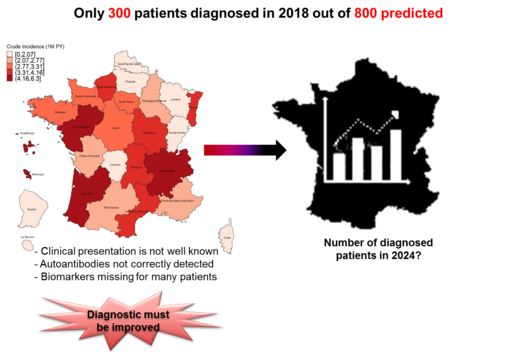WP6 - Management, valorisation and dissemination
Leader : J. Honnorat (MD, PhD, Coordinator of the FHU interest, MeLiS/Inserm U1314/UMR CNRS 5284)
Partners: All
The objective of WP6 is to set-up an efficient management and coordination structure in order to insure a good communication and collaboration between partners. In order to maximize the impact of the project, WP6 will also gather tasks linked to results exploitation and dissemination. We also plan to measure the impact of BETPSY on AE and PNS management in France at the end of the program (task 6.5) and to develop an integrative approach to exploit all the data that will be accumulated during the project.

The coordinator and WP leaders will ensure the scientific coordination of the project thanks to a daily follow-up of research activities according to strategic orientation and planning. This WP includes the management of administrative, contractual and financial tasks. A second major aspect will be the management of dissemination and exploitation activities including IP. It will ensure that the intellectual property is well monitored and protected during the course of the project and that results can be exploited properly by industrials partners and are well disseminated, through the adequate channels to reach mainly the research and the clinical communities through high profile publications but also the general public and some dedicated stakeholders that could be end users of the results. WP6 will set up 6 tasks.
Tasks: 6.1: Management
Task 6 1.1: Scientific coordination
Objectif: The scientific coordination will take place at two levels:
• Overall scientific coordination at project level by the coordinator
• Implementation and follow-up of research activities on a daily basis in each WP by their respective leaders.
Task 6.1.2: Financial and Administrative management of the project.
Objective: University Claude Bernard Lyon 1 (UCBL) will be responsible for all administrative aspects, including financial and legal aspects. The coordinator will be supported in these tasks by Lyon Ingénierie Projets (LIP) subsidiary of UCBL dedicated to research projects management.
Task 6.1.3: Internal communication and networking
Objective: Ensure a smooth internal communication and circulation of information among all partners, for the sake of the project success, but also to offer to all actors the opportunity to develop their network, and thereby expand their knowledge in their professional environment.
Task 6.2: Management of regulatory authorizations
Objective: Write all the specific inform consents and to obtain all the authorizations for each clinical study.
Task 6.3: Dissemination
Objective: The partners will establish an agreement upon dissemination plan where the following issues will be discussed: i) communication package, ii) rules for publications, iii) the listing of the end-users contacts for disseminating project outcomes.
Task 6.4 IP monitoring and Exploitation of results
Objective: At the start of the project, the Consortium Agreement will establish the IP elements committed by the partners to achieve the project. This Consortium Agreement will provide the negotiated conditions for further exploitation of the results and will include a MTA template to be used for tracking the exchanged material.
Task 6.5 Measure of the effect of BETPSY on AE and PNS in France
Objective: i) Increase the number of patients diagnosed in France; ii) Reduce the delay between the first signs and the diagnosis; iii) Reduce the delay between the first signs and the onset of immunotherapy; iv) Improve the patients outcome.
Task 6.6 Integrative approaches of biomarkers.
Objective: Considering the fantastic amount of information collected all along the BETPSY project, integrative approach appears to be an innovative way to exploit those data. This innovative approach aims at responding to assumptions of interaction or confounding effects of patient characteristics, high-throughput data. This approach will be particularly useful to compare different subgroups of AE and PNS and to approach the multiple mechanisms of these diseases


